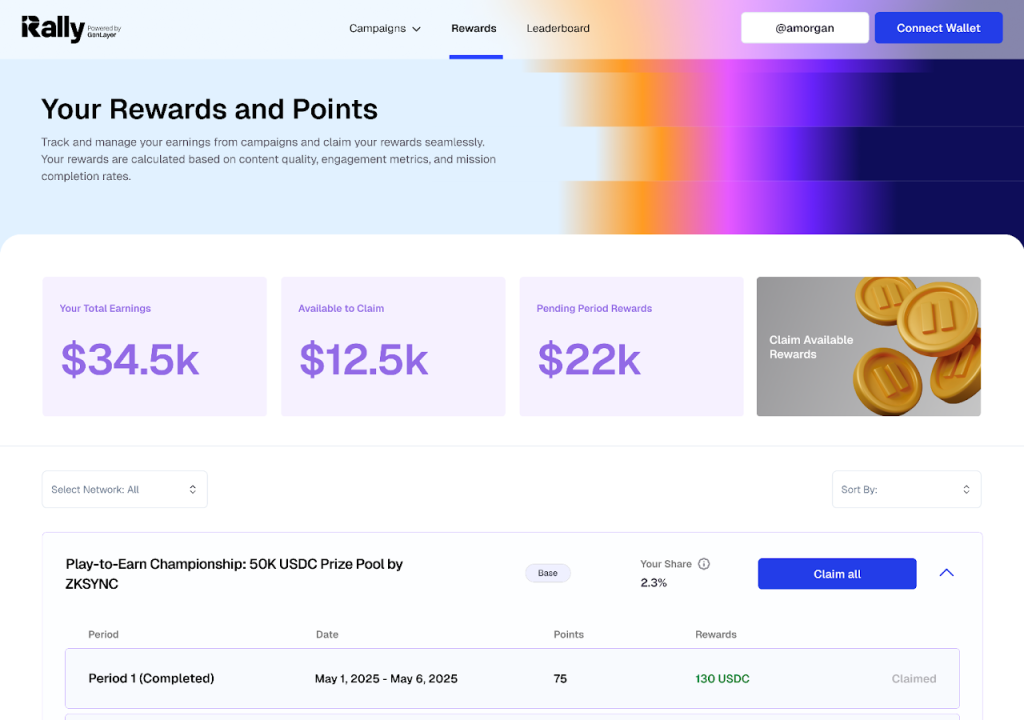Every creator knows the frustration: you deliver what feels like your best work, authentic, engaging content that resonates with your audience, only to hear that somehow it “didn’t meet expectations.” Meanwhile, brands struggle with campaigns that look great on paper but fail to drive real results. Both sides end up frustrated, pointing to different metrics to prove their point.
Rally, a new platform launching its beta this month, thinks it has the answer: replace human judgment in influencer marketing with an AI tribunal. The platform is the first real stress test for GenLayer’s infrastructure, on which Rally is built. GenLayer “Optimistic Democracy” could be thought of as an arbitration layer for subjective claims that are then settled by a collective of AI agents acting as a jury on decisions. They can agree, disagree, or grow a cohort of LLM jurors until a majority agreement is reached.
Rally’s provocative premise is that algorithmic consensus can solve what human evaluation has failed to fix. For creators who’ve spent countless hours debating campaign performance in email threads, it’s an intriguing proposition, but the real question isn’t whether the technology works, it’s whether algorithms can finally deliver the transparent, objective evaluation that both sides of the partnership have been craving.
The timing feels right for the approach. The influencer marketing industry runs on flawed assumptions: that follower counts predict performance and that engagement rates tell the whole story. Creators consistently deliver value that existing metrics can’t capture, which sparks genuine conversations, builds authentic brand affinity, and shifts audience sentiment. Yet they’re forced to defend their impact using vanity metrics that everyone knows don’t reflect real influence.
Rally’s bet is that AI can do better.
The AI Board of Directors
Rally’s core innovation is using multiple large language models that must reach consensus, GPT, Claude, Gemini, and others, as a decision-making system to evaluate influencer performance. Rather than relying on simple click-through rates or engagement counts, these AI models assess sentiment, brand fit, and performance quality before automatically triggering payments through what Rally calls “Intelligent Contracts.”
Rally operates on a four-step mission structure: projects create specific promotional tasks, crypto KOLs accept missions matching their audience, complete the required actions, and receive automatic rewards upon AI verification, whether settled directly in crypto or through simple conversions (such as ETH to USD). The system eliminates the traditional back-and-forth over whether deliverables were met.
The approach represents a significant shift from traditional crypto marketing, where campaign success often depends on subjective human evaluation and relationships with agencies or marketing managers.
Technical Ambitions Meet Market Realities
But several questions remain unanswered. How do the AI models handle cultural nuances, sarcasm, or context that might be obvious to human audiences but missed by algorithms? What happens when the AI models disagree on campaign effectiveness? And perhaps most importantly, will brands and creators trust machines to make judgment calls that could significantly impact their revenue?
The question isn’t whether the tech works. It’s whether brands and creators actually want fully automated relationships. Marketing has always been about human connections.
There’s also the question of training data and bias. AI models are trained on existing content, potentially encoding existing biases about what constitutes effective marketing. This could systematically favor certain types of creators or content styles while penalizing innovative approaches that don’t match historical patterns.
The Broader AI Commerce Bet
The fact that Rally is being built on GenLayer positions the platform as more than just an influencer marketing tool. It’s a proof of concept for AI-mediated commerce. If successful, it could demonstrate that algorithms can handle subjective business decisions traditionally requiring human judgment.
This is about more than just marketing. Rally is testing whether creators can build sustainable businesses on infrastructure they own, rather than being dependent on platform policy changes.
The timing feels significant. As AI capabilities rapidly advance, there’s growing interest in autonomous agents that can operate independently in economic systems. Rally represents an early test of whether this vision can work in practice, starting with an industry already struggling with trust and measurement challenges.
Navigating KOL Complexities and Risk Factors
Despite the tech’s promise, several concerns warrant attention. The influencer marketing industry’s value often lies in authenticity and personal connection, qualities that may be difficult for AI to assess accurately. Creators build audiences through personality and relatability, not just content quality. Can algorithms truly evaluate whether a sponsored post feels genuine to human followers?
Rally’s mission structure, while providing clarity, may constrain creative freedom. Traditional influencer relationships often produce the best content when creators have flexibility to interpret brand messages for their specific audiences.
The protocol’s Web3 focus may also limit mainstream appeal. While crypto projects might embrace algorithmic decision-making, traditional brands may prefer the relationship-based approach that has defined influencer marketing to date.
Market timing presents another challenge. The crypto marketing sector, while growing, remains a fraction of the broader influencer economy. Rally’s success depends partly on whether Web3 marketing budgets expand sufficiently to support dedicated protocol infrastructure.
Market Dynamics and Competition
Rally enters a crowded field of companies attempting to bring more accountability to influencer marketing. Platforms like AspireIQ, Grin, and Creator.co already offer sophisticated analytics and campaign management tools. What Rally offers is something different: AI as judge, jury, and bookkeeper.
The platform’s differentiation lies in full automation and on-chain transparency, but these features could prove less valuable than anticipated if creators prefer human oversight. Rally must prove its AI evaluation produces better outcomes than human judgment, a difficult proposition in relationship-driven marketing.
Competition exists in adjacent areas, but Rally’s approach represents a fundamental shift rather than incremental improvement. The mission-based structure, automated AI evaluation, and on-chain transparency create an entirely new category of decentralized marketing protocols.
Beta Program and What’s at Stake
Rally’s beta program began this month with the goal of onboarding a growing list of initial partners. The team is targeting crypto projects, Web3 marketing agencies, and established crypto KOLs for early participation. Beta partners receive campaign matching grants, priority support, and influence over product development.

The platform launches with open access. Any creator can join, and any project can create campaigns. Success metrics for the beta will likely include transaction volume, creator retention, and campaign performance relative to traditional methods.
For crypto creators, the platform offers potential solutions to persistent payment and evaluation issues, but requires trusting algorithmic judgment over human relationships. Early adoption could provide competitive advantages if the system gains traction, but also carries risks if AI evaluation proves inadequate or biased.
Looking Forward: AI Learns to Do Business
Rally’s success will likely depend on demonstrating concrete value to both brands and creators, proving that AI judgment can enhance rather than complicate influencer partnerships. The platform is an early stress test of whether algorithmic arbitration can work in an industry built on human relationships, albeit broken ones.
The Rally Foundation says it’s building toward a future where “AI learns to do business.” The real question is whether creators and brands will let it. Rally’s beta results will likely influence broader development of AI-powered business protocols and determine whether automated marketing evaluation represents genuine progress or technological complexity without corresponding value.
While the platform is accepting influencers on a case-by-case basis during beta, the broader implications extend far beyond marketing. As AI systems become more sophisticated at understanding context and nuance, algorithmic mediation of business relationships may become increasingly viable. Rally could be an early indicator of this trend.
The author holds no financial positions in GenLayer, Rally Foundation, or competing platforms mentioned.













